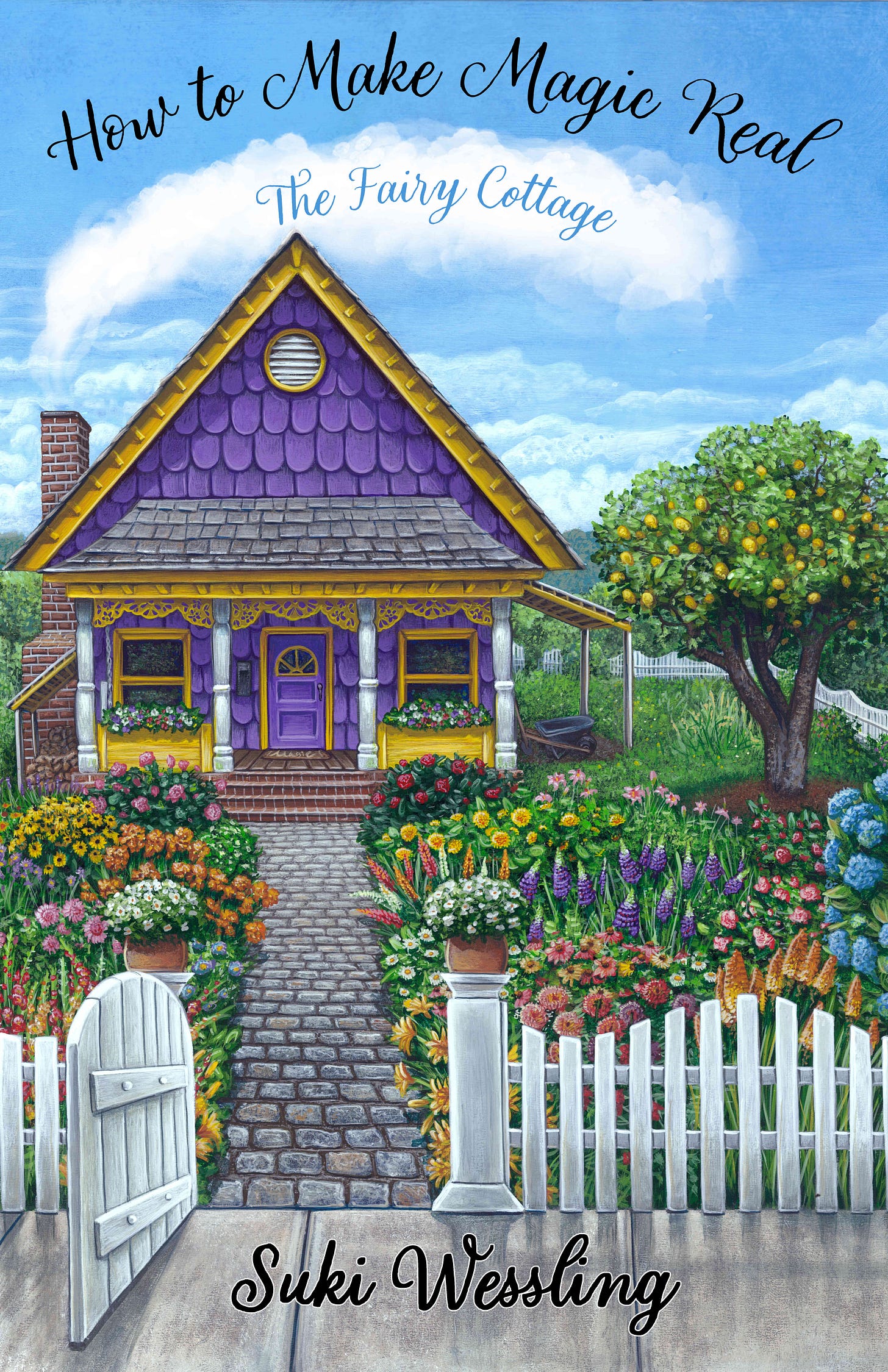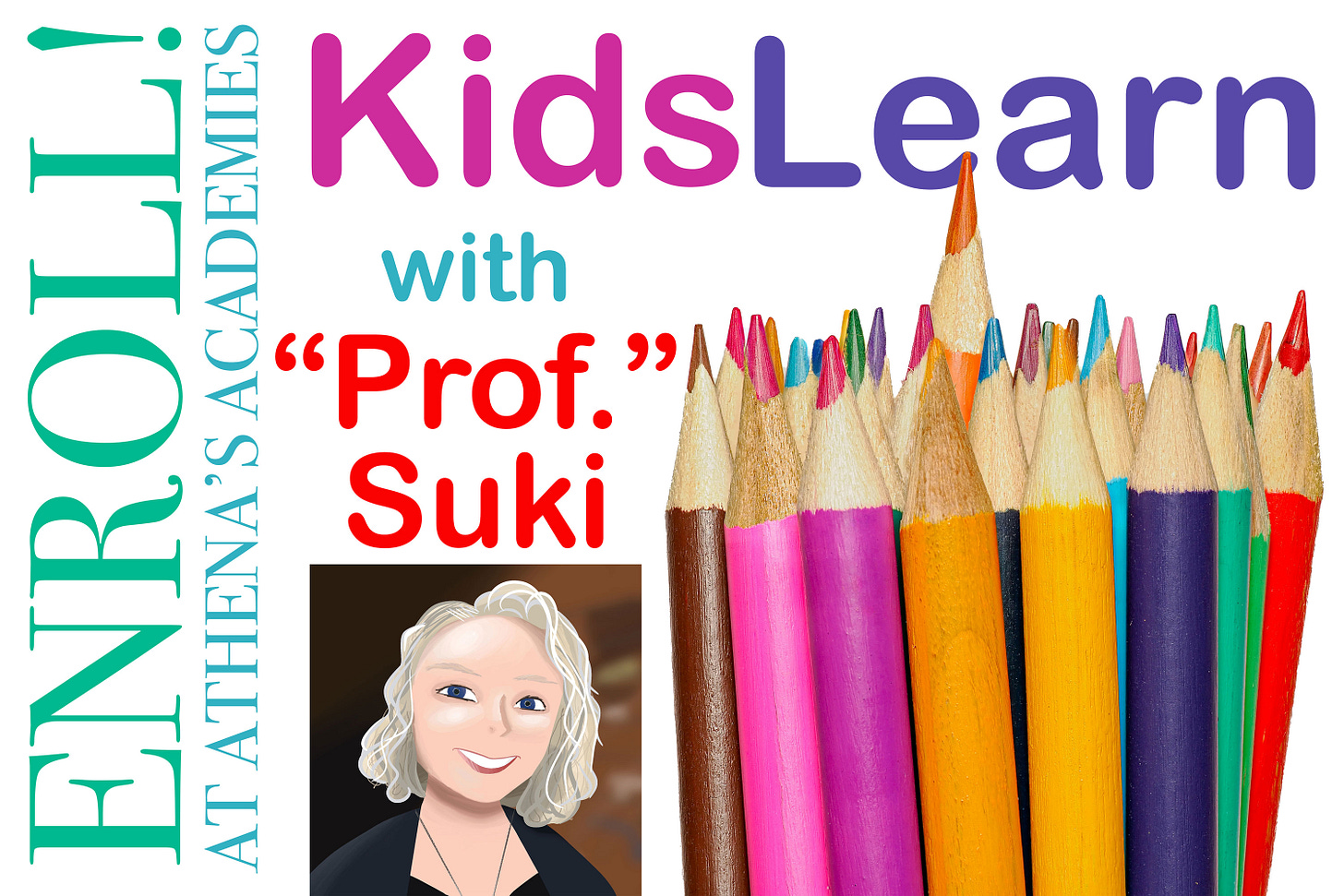Every time I start writing a new novel, a voice inside me says, “This is the one that will be mainstream enough for a publisher.” Eventually, I end up affectionately tucking that voice back into bed. But in the meantime, I take some time to give a little love to the dream of my childhood.
The KidsLearn Substack is written by Suki Wessling, known as “Prof.” Suki to her students. Scroll to the bottom for links to Suki’s work and more information. If you enjoy my work, please interact with this post. A “like” or comment goes a long way and will make my day!
Born a writer
Like most writers of children’s books, I was a reader. I grew up in a loud family of seven, and I was always trying to escape. In the summertime, I found a nook shaped like a lounge chair up in an apple tree in our yard. I’d bring my books and notebook up there, and giggle to myself when family members would walk by underneath, not knowing I was there. In the winter I took refuge in a cupboard inside of a closet. I’d bring a flashlight, close the closet door after me (directly contradicting the advice of the Pevensie children), and climb up into the cupboard where I could truly be alone.
None of my hiding places ever led me to a magical forest, but they did train me to think of myself as a writer. Ever since I was a child, I’ve had nonstop stories playing in my head. Sometimes they are replays of real-life conversations, which might lead to essays. Sometimes they are imaginings inspired by a small event in my life, and they lead to stories. Many of those stories get started, and a few get finished. But it’s the process that matters most to me. As I tell my students, I don’t know what I think until I write it down.
Enter anxiety
During the pandemic, my teaching life changed dramatically. Unlike most teachers, though, I didn’t have to learn how to teach online—I was already doing it. What I did have to do was integrate a large number of former school children into my classes. Those children were not used to online learning, and they weren’t used to learning just for the fun of it. They asked the sorts of questions I hadn’t heard since I taught Freshman Comp: “Is this required?” “How do I get a good grade?” They were disoriented and stressed out, often finding my classes after a school had parked them in front of a computer for 6 hours straight, expecting them to sit still and behave as if the world weren’t falling down around us.
My continuing students, largely homeschooled or in other alternative education environments, should have been equipped to weather the pandemic more smoothly, but they were also anxious. One student confided that she and her sibling were locked into a 2-bedroom urban apartment with their parents and hadn’t been outside in months. I started to give assignments that required students to go outside, or barring that, look out a window, or barring that, look on Google Earth at the goodness of nature that the Earth has given us.
My students were filled with anxiety. They initiated discussions about illness and death. In my etymology class, students researched the root words of “pandemic” and “Covid” and “epidemiology.” I’d had plenty of students with mental health diagnoses before—that’s a given in the population of gifted and twice-exceptional children that I teach. But these anxieties were different.
What would happen if a fairy wanted to become a computer scientist?
One day in a writing class, I led my students through a process of taking two completely unrelated ideas and building a plot out of them. Earlier that day, I’d randomly typed an idea to share with them: “In my story, a fairy godmother wants to get a wish of her own granted. She wants to stop being a fairy and become a computer scientist.”
My students reacted with great enthusiasm to the assignment and to my idea. “You should write that!” several of them urged. So I did.
There are many writing teachers who will teach you how to structure a plot like Hollywood, the right way to create characters, and to write in a way that everyone will approve of. That never appealed to me. I love the mystery of finding the story. My favorite writing book when I was an undergraduate was Peter Elbow’s Writing Without Teachers. He emphasized the idea of dumping uncensored ideas onto the page—freewriting. He believed that you could find the best writing by sculpting it out of the mess of your brain.
The mess of my brain created a girl who loved to write (big surprise!) and a fairy frustrated with the imprudent wishes of impulsive humans. I dumped the computer science aspect—my fairies have absolutely no idea what “compooters” do. But I let my Ada suffer silently from her anxiety as her new fairy friend finds a way into her barricaded heart.
An agent’s word
I took the first draft of the book that has become How to Make Magic Real to a children’s writing conference, where I met with an agent to review my opening chapters. She was enthusiastic—she said that the world of children’s literature needed a book about anxiety caused by world events like the pandemic. As our meeting concluded, another agent, a friend of hers, walked up to us. He told us that he couldn’t find an editor to take on a longtime author of his, a wonderful writer with a long steady career.
“The industry just doesn’t want quiet, deep stories anymore,” he said.
That could have served as a warning, but buoyed by the agent’s positive response to my opening chapters, I revised and sent her the manuscript. I got a nice no. I queried the other agent I’d met. No. I queried agents who had represented similar books. No. I queried every agent who represented middle grade fiction at all. No no no.

Our new publishing universe
Self-publishing used to be seen as a sad place for inept wannabe authors or published authors who’d written such a stinker no one would take it on. Some in the industry still see it that way. But while the legacy industry chugs along trying to find the next big hit, a quiet revolution has happened online.
I’m not the only author who sees on-demand publishing as a legitimate alternative. I know that my book isn’t the next big hit. I know that my target audience is small, though I also know that they crave “quiet, deep” books. But when you can spend literally zero dollars to bring a book to the world, you have a lot more options than the narrow path that the industry presents.
I actually did spend dollars to bring my book to the world. I hired a wonderful artist, Cara Bevan, to paint the portrait of the Fairy Cottage above. Luckily, I’ve designed books before and feel pretty confident of my skills, so I didn’t have to pay for a designer.1 I will incur other expenses as I work to spread the word about the book.
But to me, the money is definitely not the point. I’d love to make a profit, of course. But as I tell my students over and over, it’s all about the process. Writing, revising, and publishing this book has made me a better writer, a better teacher, and a more thoughtful person. Going through this process always helps writers grow.
How to Make Magic Real coming soon to a mailbox near you!
Perhaps my next book will be one that appeals to the industry, but right now I’m not focused on that. I’m working to make this little book the best little book it can be. One of my young beta readers said:
Your book is great! I admire the skill it must take to write about the horrors of grief in a way that I am legitimately confident won't scar the target audience of eight to twelve year old girls reading this book.
What more could I ask than that?

And to tell you the truth, I’m sure no professional designer would have been as fanciful as I was when it came to the interior design.






